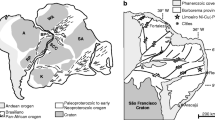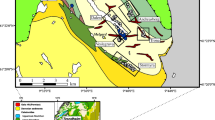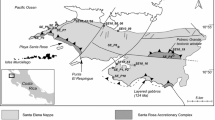Abstract
Although Cu-sulfide mineralization within the Loolekop pipe of the Phalaborwa Igneous Complex has been extensively studied, certain aspects of the sulfide metallogenesis remain unclear. This research aims to constrain the relative timing and processes involved in Cu-sulfide mineralization within the Loolekop pipe through textural analysis and trace element composition of the three different types of sulfide assemblages in this intrusion. The first primary magmatic mineralization phase contains dispersed bornite with chalcopyrite exsolution and local traces of chalcocite and covellite related to fluid alteration, whereas the second primary phase is characterized by veins of chalcopyrite with cubanite exsolution. The third mineralization phase relates to leaching of primary sulfide assemblages by oxidizing fluids, resulting in desulfurization and the formation of valleriite [(Fe2+,Cu)4(Mg,Al)3S4(OH,O)6] and magnetite. Whole-rock ICP-MS analyses of platinum-group elements (PGE) indicate a mantle origin of the primary Cu-sulfides (bornite-chalcopyrite assemblages). In situ trace element analyses of sulfide assemblages also show evidence of external material input, most likely of crustal origin, during magma and sulfide liquid ascent, before decoupling of the sulfide liquid and the melt, although the exact source is unclear. The enrichment of Pd-group PGE (PPGE: Pd, Pt) over Ir-group PGE (IPGE: Os, Ir, Ru) in Cu-sulfide phases suggests the presence of an intermediate solid solution (iss)-monosulfide solid solution (mss) system. It is proposed that a Cu- and PPGE-enriched sulfide liquid fractionated from an IPGE-enriched mss, followed by the formation of an iss, and finally the extraction of a PPGE-rich Cu-liquid from the iss forming the bornite-chalcopyrite assemblages. Sulfide textures and the presence of chalcopyrite veins suggest that the iss was leached by high-temperature hydrothermal fluids at depth that remobilized and precipitated Cu along the fractures within the intrusion. Subsequently, all the primary magmatic phases were affected by late-stage fluids, which triggered their alteration into valleriite, also precipitating along fractures within the Loolekop pipe.











Similar content being viewed by others
References
Aldous RTH (1986) Copper-rich fluid inclusions in pyroxenes from the guide copper mine, a satellite intrusion of the Palabora Igneous Complex, South Africa. Econ Geol 81:143–155
Auge T, Petrunov R, Bailly L (2005) On the origin of the pge mineralization in the elatsite porphyry cu au deposit, Bulgaria: comparison with the baula nuasahi complex, India, and other alkaline pge-rich porphyries. The Canadian Mineralogist 43:1355–1372
Bai L, Barnes S-J, Baker DR (2017) Sperrylite saturation in magmatic sulfide melts: implications for formation of PGE-bearing arsenides and sulfarsenides. Am Mineral 102:966–974
Ballhaus C, Sylvester PJ (2000) Noble metal enrichment processes in the Merensky Reef, Bushveld complex. J Petrol 41:545–561
Barnes S-J (2016) Chalcophile elements in: white WM (ed) Encyclopedia of geochemistry. Springer International Publishing, Cham, pp 1–5
Barnes S-J, Ripley EM (2016) Highly siderophile and strongly chalcophile elements in magmatic ore deposits In: Harvey J, Day JMD (eds) Highly siderophile and strongly chalcophile elements in high-temperature geochemistry and cosmochemistry. Mineralogical Society of America & Geochemical Society, pp 725–774
Barnes S-J, Makovicky E, Makovicky M, Rose-Hansen J, Karup-Moller S (1997) Partition coefficients for Ni, Cu, Pd, Pt, Rh, and Ir between monosulfide solid solution and sulfide liquid and the formation of compositionally zoned Ni-Cu sulfide bodies by fractional crystallization of sulfide liquid. Can J Earth Sci 34:366–374
Barnes S-J, van Achterbergh E, Makovicky E, Li C (2001) Proton microprobe results for the partitioning of platinum-group elements between monosulphide solid solution and sulphide liquid. S Afr J Geol 104:275–286
Barnes S-J, Cox RA, Zientek ML (2006) Platinum-group element, gold, silver and base metal distribution in compositionally zoned sulfide droplets from the Medvezky Creek Mine, Noril’sk, Russia. Contrib Mineral Petrol 152:187–200. https://doi.org/10.1007/s00410-006-0100-9
Barnes S-J, Prichard HM, Cox RA, Fisher PC, Godel B (2008) The location of the chalcophile and siderophile elements in platinum-group element ore deposits (a textural, microbeam and whole rock geochemical study): implications for the formation of the deposits. Chem Geol 248:295–317
Basson I, Lourens P, Paetzold H-D, Thomas S, Brazier R, Molabe P (2017) Structural analysis and 3D modelling of major mineralizing structures at the Phalaborwa copper deposit. Ore Geol Rev 83:30–42
Bockrath C, Ballhaus C, Holzheid A (2004) Fractionation of the platinum-group elements during mantle melting. Science 305:1951–1953
Bolhar R, Whitehouse MJ, Milani L, Magalhães N, Golding SD, Bybee G, Le Bras L, Bekker, A (2020) Atmospheric S and lithospheric Pb in sulphides from the 2.06 Ga Phalaborwa phoscorite-carbonatite complex, South Africa. Earth and Planetary Science Letters 530. doi: https://doi.org/10.1016/j.epsl.2019.115939
Canali AC, Brenan JM, Sullivan NA (2017) Solubility of platinum-arsenide melt and sperrylite in synthetic basalt at 0.1 MPa and 1200 °C with implications for arsenic speciation and platinum sequestration in mafic igneous systems. Geochim Cosmochim Acta 216:153–168. https://doi.org/10.1016/j.gca.2017.05.006
Cawthorn RG, Meyer FM (1993) Petrochemistry of the Okiep Copper District basic intrusive bodies, northwestern Cape Province, South Africa. Econ Geol 88:590–605
Craig JR, Vaughan DJ (1994) Ore microscopy and ore petrography, 2nd edn. Wiley, Hoboken
Dare SAS, Barnes S-J, Prichard HM (2010) The distribution of platinum group elements (PGE) and other chalcophile elements among sulfides from the Creighton Ni-Cu-PGE sulfide deposit, Sudbury, Canada, and the origin of palladium in pentlandite. Mineral Deposita 45:765–793. https://doi.org/10.1007/s00126-010-0295-6
Dare SAS, Barnes S-J, Prichard HM, Fisher PC (2011) Chalcophile and platinum-group element (PGE) concentrations in the sulfide minerals from the McCreedy East deposit, Sudbury, Canada, and the origin of PGE in pyrite. Mineral Deposita 46:381–407. https://doi.org/10.1007/s00126-011-0336-9
Durazzo A, Taylor LA (1982) Experimental exsolution textures in the system bornite-chalcopyrite: genetic implications concerning natural ores. Mineral Deposita 17:79–97
Dutrizac JE (1976) Reactions in cubanite and chalcopyrite. Can Mineral 14:172–181
Eriksson SC (1982) Aspects of the petrochemistry of the Phalaborwa Complex, Northeastern Transvaal, South Africa Faculty of Science. University of the Witwatersrand, pp 496
Eriksson SC (1989) Phalaborwa: a saga of magmatism, metasomatism and miscibility carbonatites: genesis and evolution. Unwin Hyman, London, pp 221–254
Farmer GL, Perry FV, Semken S, Crowe B, Curtis D, DePaolo DJ (1989) Isotopic evidence on the structure and origin of subcontinental lithospheric mantle in southern Nevada. J Geophys Res 94:7885. https://doi.org/10.1029/JB094iB06p07885
Forster IF (1958) Paragenetical ore mineralogy of the Loolekop-Phalaborwa carbonatite complex, eastern Transvaal. S Afr J Geol 61:359–365
Giebel RJ, Marks MAW, Gauert CDK, Markl G (2019) A model for the formation of carbonatite-phoscorite assemblages based on the compositional variations of mica and apatite from the Palabora carbonatite complex, South Africa. Lithos 324-325:89–104. https://doi.org/10.1016/j.lithos.2018.10.030
Goldschmidt VM (1937) The principles of distribution of chemical elements in minerals and rocks. The seventh Hugo Müller Lecture, delivered before the Chemical Society on March 17th, 1937. Journal of the Chemical Society
Groves DI, Vielreicher NM (2001) The Phalaborwa (Palabora) carbonatite-hosted magnetite-copper sulfide deposit, South Africa: an end-member of the iron-oxide copper-gold-rare earth element deposit group? Mineral Deposita 36:189–194
Hanekom HJ, Van Standen CM, Smit PJ, Pike DR (1965) The geology of Palabora igneous complex, South Africa Geological Survey Handbook Memoir 54
Heaman LM, LeCheminant AN (1993) Paragenesis and U-Pb systematics of baddeleyite (ZrO2). Chem Geol 110:95–126
Heinrich EW (1970) The Palabora carbonatitic complex-a unique copper deposit. Can Mineral 10:585–598
Helmy HM, Ballhaus C, Wohlgemuth-Ueberwasser CC, FR OC, Laurenz V (2010) Partitioning of Se, As, Sb, Te and Bi between monosulfide solid solution and sulfide melt-application to magmatic sulfide deposits. Geochim Cosmochim Acta 74:6174–6179
Holwell DA, McDonald I (2010) A review of the behaviour of platinum group elements within natural magmatic sulfide ore systems. Platinum Mineral Review 54:26–36. https://doi.org/10.1595/147106709X480913
Klemd R, Herderich T, Junge M, Oberthür T, Schouwstra R, Roberts J (2016) Platinum-group element concentrations in base-metal sulphides from the Platreef, Mogalakwena Platinum Mine, Bushveld Complex, South Africa. S Afr J Geol 119:623–638
Knight RD, Prichard HM, Ferreira Filho CF (2017) Evidence of As contamination and the partitioning of Pd into pentlandite and Co + Platinum Group Elements into pyrite in the Fazenda Mirabela Intrusion, Brazil. Econ Geol 112:1889–1912
Li K, Brugger J, Pring A (2018) Exsolution of chalcopyrite from bornite-digenite solid solution: an example of a fluid-driven back-replacement reaction. Mineral Deposita 53:903–908. https://doi.org/10.1007/s00126-018-0820-6
Lombaard AF, Ward-Able NM, Bruce RW (1964) The exploration and main geological features of the copper deposit in carbonatite Loolekop, Palabora complex In: Haughton SH (ed) The geology of some ore deposits in Southern Africa. Geological Society of South Africa, Johannesburg, p 23
Lyubetskaya T, Korenaga J (2007) Chemical composition of Earth’s primitive mantle and its variance: 1. Method and results. Journal of Geophysical Research 112. https://doi.org/10.1029/2005JB004223
Maier WD, Barnes S-J (1996) Unusually high concentrations of magnetite at Caraíba and other Cu-sulfide deposits in the Curaçá valley, Bahia, Brazil. Can Mineral 34:717–731
Maier WD, Barnes S-J (2004) Pt/Pd and Pd/Ir ratios in mantle-derived magmas: a possible role for mantle metasomatism. S Afr J Geol 107:333–340
Maier WD, Andreoli MAG, Groves DI, Barnes S-J (2012) Petrogenesis of Cu-Ni sulphide ores from O’okiep and Kliprand, Namaqualand, South Africa: constraints from chalcophile metal contents. S Afr J Geol 115:499–514
Milani L, Bolhar R, Cawthorn RG, Frei D (2017a) In situ LA–ICP-MS and EPMA trace element characterization of Fe–Ti oxides from the phoscorite–carbonatite association at Phalaborwa, South Africa. Mineral Deposita 52:747–768
Milani L, Bolhar R, Frei D, Harlov DE, Samuel VO (2017b) Light rare earth element systematics as a tool for investigating the petrogenesis of phoscorite-carbonatite associations, as exemplified by the Phalaborwa Complex, South Africa. Mineral Deposita 52:1105–1125
Mungall JE, Andrews DRA, Cabri LJ, Sylvester PJ, Tubrett M (2005) Partitioning of Cu, Ni, Au, and platinum-group elements between monosulfide solid solution and sulfide melt under controlled oxygen and sulfur fugacities. Geochim Cosmochim Acta 69:4349–4360
Palabora Mining Company Ltd Staff (1976) The geology and the economic deposits of copper, iron, and vermiculite in the Palabora Igneous Complex: a brief review. Econ Geol 71:177–192
Peach CL, Mathez EA, Keays RR (1990) Sulfide melt-silicate distribution coefficients for noble metals and other chalcophile elements as deduced from MORB: implications for partial melting. Geochim Cosmochim Acta 54:3379–3389
Piña R, Gervilla F, Barnes S-J, Ortega L, Lunar R (2012) Distribution of platinum-group and chalcophile elements in the Aguablanca Ni-Cu sulfide deposit (SW Spain): evidence from a LA-ICP-MS study. Chem Geol 302-302:61–75. https://doi.org/10.1016/j.chemgeo.2011.02.010
Ramdohr P (1969) The ore minerals and their intergrowths. Akademie-Verlag, Berlin
Reischmann T (1995) Precise U/Pb age determination with baddeleyite (ZrO2), a case study from the Phalaborwa igneous complex, South Africa. S Afr J Geol 98:1–4
Rudashevsky NS, Kretser YL, Rudashevsky VN, Sukharzhevskaya ES (2004) A review and comparison of PGE, noble-metal and sulphide mineralization in phoscorites and carbonatites from Kovdor and Phalaborwa. In: Zaitsev A, Wall F (eds) Phoscorites and carbonatites from mantle to mine: the key example of the Kola Alkaline Province. Mineralogical Society, London, pp 363–392
Rudnick RL, Gao S (2003) Composition of the continental crust. In: Holland HD, Turekian KK (eds) Treatise on geochemistry. Elsevier, Amsterdam, pp 1–64
Schwartz GM (1927) Intergrowths of chalcopyrite and cubanite: experimental proof of the origin of intergrowths and their bearing on the geologic thermometer. Econ Geol 22:44–61
Sun S, McDonough WF (1989) Chemical and isotopic systematics of oceanic basalts: implications for mantle composition and processes. In: Saunders AD, Norry MJ (eds) Magmatism in the ocean basins. Geological Society Special Publication, pp 313–345
van Achterbergh E, Ryan CG, Griffin WL (2000) GLITTER on-line interactive data reduction for LA-ICPMS. Macquarie Research Ltd.
Vielreicher NM, Groves DI, Vielreicher RM (2000) The Phalaborwa (Palabora) deposit and its potential connection to iron-oxide copper-gold deposits of olympic dam type. In: Porter TM (ed) Hydrothermal iron oxide copper-gold & related deposits: a global perspective. PGC Publishing, Adelaide, pp 321–329
Wohlgemuth-Ueberwasser CC, Ballhaus C, Berndt J, Stotter nee Paliulionyte V, Meisel T (2007) Synthesis of PGE sulfide standards for laser ablation inductively coupled mass spectrometry (LA-ICP-MS). Contrib Mineral Petrol 154:607–617. https://doi.org/10.1007/s00410-007-0212-x
Wu F-Y, Yang Y-H, Li Q-L, Mitchell RH, Dawson JB (2011) In situ determination of U-Pb ages and Sr-Nd-Hf isotopic constraints on the petrogenesis of the Phalaborwa carbonatite Complex, South Africa. Lithos 127:309–322
Yuhara M, Kohno M, Kagami H, Hiroi Y, Tsuchiya N (2003) Geochemistry of syenite of the Phalaborwa carbonatite complex, South Africa. Polar Geoscience 16:176–195
Acknowledgments
We would like to thank the Palabora Mining Company for providing access to sample drill core material. Helene Brätz and Reiner Klemd at the GeoZentrum Nordbayern in Erlangen contributed the LA-ICP-MS analyses. Marlin Patchappa produced whole-rock major and trace element data, and Caiphas Majola prepared and polished blocks, both at the University of the Witwatersrand. The support of the DSI-NRF Centre of Excellence for Integrated Mineral and Energy Resource Analysis (DSI-NRF CIMERA) towards this research is hereby acknowledged. R. Bolhar acknowledges financial support to establish the ICP-MS facility at the University of Witwatersrand through a National Research Foundation–National Equipment Programme (NRF-NEP) grant (UID 105674).
Author information
Authors and Affiliations
Corresponding author
Ethics declarations
Disclaimer
Opinions expressed, and conclusions arrived at, are those of the authors and are not necessarily to be attributed to the DSI-NRF CIMERA.
Additional information
Editorial handling: W. D. Maier
Publisher’s note
Springer Nature remains neutral with regard to jurisdictional claims in published maps and institutional affiliations.
Electronic supplementary material
ESM 1
(XLSX 357 kb)
Rights and permissions
About this article
Cite this article
Le Bras, L.Y., Bolhar, R., Bybee, G.M. et al. Platinum-group and trace elements in Cu-sulfides from the Loolekop pipe, Phalaborwa: implications for ore-forming processes. Miner Deposita 56, 161–177 (2021). https://doi.org/10.1007/s00126-020-01005-4
Received:
Accepted:
Published:
Issue Date:
DOI: https://doi.org/10.1007/s00126-020-01005-4




